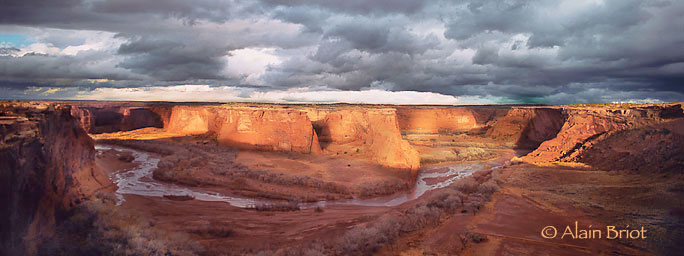1 - Canyon de Chelly
For seven years, from August 1997 to December 2003, I lived in at the mouth of Canyon de Chelly National Monument, only a few minutes from some of the most breathtaking vistas in the Southwest. As one of my customers remarked "you must photograph Canyon de Chelly a lot then!" Well, I certainly do, and the photographs below attest to this fact.
Canyon de Chelly is the second largest canyon in Arizona the first being, by far, the Grand Canyon. Canyon de Chelly (pronounced" de Shay") is located on the Navajo Reservation and is considered the "center" of the Navajo world.
Comprising a canyon system totalling over a hundred miles Canyon de Chelly consists of two main drainages: Canyon del Muerto and Canyon de Chelly. Both canyons can be explored in your own four wheel drive vehicle after hiring a Navajo guide at the Canyon de Chelly Visitor Center in Chinle, Arizona. If you do not have four wheel drive or would prefer not to use your own vehicle you can take a group tour in a six wheel drive truck from the Thunderbird Lodge in Chinle or explore the Canyon in a Jeep with the Canyon de Chelly Jeep Tours. Information on these different tours is available at the Park Visitor Center.
The wonderful thing about living next to Canyon de Chelly, besides driving to one of the overlooks for sunset after a hard days work, is the opportunity to photograph the canyon in widely different weather conditions.
Some of the most exciting opportunities for me are provided when there is a snowstorm. I usually head out early in the morning after a storm knowing that the snow will melt rapidly once the sun comes up since temperatures usually rise above freezing even in the winter. Four wheel drive is often necessary to reach the overlooks in snowy conditions since the overlook roads, although paved, are not plowed.
2 - Navajo Hogans
The Hogan is the traditional Navajo dwelling. It is a wooden structure built either of stacked log or logs laid vertically in a circular fashion. The roof is made of logs as well and may be covered with adobe. Hogans are circular structures and have a single doorway which opens East towards the location of the rising sun when the hogan was built.
Living on the Navajo Reservation provides me with many opportunities to observe and photograph hogans. The oldest examples may be several hundred years old and the new ones only a few months old since hogans continue to be built today.
In the past all Navajos lived in Hogans. Today, only older, more traditional Navajos live in them permanently the younger generation preferring to live in modern housing. Today Hogans are often used to conduct the many ceremonies which are part of Navajo religious practices.
To me the hogan is one of the purest representations of a home. I particularly like the simplicity of their construction and the way they blend with the surrounding landscape. The place where a Hogan is located is often as important as the hogan itself. The hogan becomes part of the landscape and adds to it rather than detract from it. Often hogans are found in the most beautiful locations, deep into Canyon de Chelly at the base of a giant sandstone wall, at the border of a sand dune whose ripples send waves of light towards the horizon, in the middle of a wide plains onto which, at sunset, the hogan casts a mile-long shadow.
The isolated locations in which many of the older hogans are found adds to their fascination. Often these locations were deserted a long time ago and no roads lead to them. One has to hike and often comes upon these structures by accident. In front of this deserted dwelling one has to reconstruct life as it once was: the paths these past residents used, the furnishings inside the house as they once were, the presence of a corral next to the hogan in which they kept horses and sheep. All which is left of this life is now contained in the aging hogan itself and in its relationship with the landscape around it.
 |
Clearing Spring Storm, Canyon de Chelly, Arizona